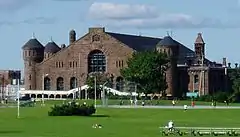1st (Halifax-Dartmouth) Field Artillery Regiment
The 1st (Halifax-Dartmouth) Field Artillery Regiment, RCA, is a Canadian Forces reserve artillery regiment. It is located in Halifax, Nova Scotia, at 73 Hobson Lake Drive. The unit consists of two batteries, 51st and 84th Field Batteries (87th Field Battery existing only on paper since the late 1990s).[1] There are two Units located within 1st (Halifax-Dartmouth) Field Artillery Regiment. One is in Halifax and the other is the 84th Independent Field Battery located in Yarmouth NS. Each share the same Commanding Officer.
| Part of a series on the |
| Military history of Nova Scotia |
|---|
 |
|
| 1st (Halifax-Dartmouth) Field Artillery Regiment, RCA | |
|---|---|
| Active | 1791–present |
| Country | Canada |
| Branch | Land Force Reserve |
| Type | Field Artillery |
| Size | Regiment |
| Garrison/HQ | 73 Hobson Lake Drive, Halifax |
The regiment traces its lineage back to the Halifax Volunteer Artillery, which may have been in existence as early as 1776. The unit was officially recognized in 1791 and served into the mid-19th century, when it underwent a series of name changes. In 1885, the unit, then known as the 1st "Halifax" Brigade of Garrison Artillery, sent two batteries with the Halifax Provisional Battalion to participate in the suppression of North-West Rebellion. At the onset of World War I the 1st Halifax, by then designated as the 1st "Halifax" Regiment, CA, was called to active duty. It provided home defence in Halifax and served as a training unit for new artillery recruits throughout the war. It reverted to militia status after the end of the conflict and went through another series of name changes.[1]
In 1939, as World War II loomed, the unit, by then known as the "1st (Halifax) Coast Brigade, RCA", was again called to active service. As in World War I, the 1st Halifax served in a home defence capacity and trained new recruits. The unit was re-designated as the "1st (Halifax) Heavy Anti-Aircraft Regiment, RCA" in 1942 and armed with British-made QF 3.7 inch AA guns.[1]
After the end of World War II, in 1955, the unit was re-armed with American-made 90 mm guns and re-designated as a Medium Anti-Aircraft Regiment. It acquired its current name, the 1st (Halifax-Dartmouth) Field Artillery Regiment, RCA, in 1960 when it was issued 105 mm howitzers and merged with the 36th Medium Anti-Aircraft Regiment, RCA, from Eastern Passage, Nova Scotia.
See also
Armoury
In 2012 Regimental Headquarters (RHQ) and 51 Battery, moved from the Halifax Armoury to their new facility at 73 Hobson Lake Drive. This building, which was purpose built to facilitate an artillery battery, is often used for Basic Military Qualification Courses (BMQ) and other training courses and conferences.
| Site | Date(s) | Designated | Location | Description | Image |
|---|---|---|---|---|---|
| Halifax Armoury 2667 North Park Street |
1895-99 (completed) | National Historic Sites of Canada; Classified - 1991 Register of the Government of Canada Heritage Buildings | north central Halifax Regional Municipality |
Housing 1st (Halifax-Dartmouth) Field Artillery Regiment, and The Princess Louise Fusiliers this large, urban, Romanesque Revival drill hall, was built for the active militia, of red rough faced brick |
 |
Order of precedence
| Preceded by 5e Régiment d'artillerie légère du Canada |
1st (Halifax-Dartmouth) Field Artillery Regiment | Succeeded by 1st (Halifax-Dartmouth) Field Artillery Regiment, RCA of Royal Canadian Artillery |
References
- "History of 1st Field Artillery Regiment". Canadian Army. 2008-12-01. Archived from the original on 2011-06-14. Retrieved 2008-12-13.
Media
- Shelldrake: Canadian Artillery Museums and Gun Monuments by Harold A. Skaarup (Feb 1 2012)
- Officers Who Served Overseas in the Great War with the Canadian Artillery 1914-1919 by Canadian Artillery Association (Sep 1 2011)
- Battery Flashes of W.W. II: A Thumb-Nail Sketch of Canadian Artillery Batteries during the 1939-1945 Conflict by D. W. Falconer (1985)
| Wikimedia Commons has media related to 1st (Halifax-Dartmouth) Field Artillery Regiment. |
